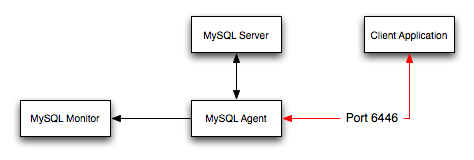- 9.1 Enabling Query Analyzer
- 9.1.1 Enabling Query Analyzer by Changing the MySQL Client Application
- 9.1.2 Enabling Query Analyzer by Changing MySQL Server
Generally, changing your MySQL client application is the easiest and recommended method. For example, given a typical structure like the one shown in the figure below, the client application would need to be modified so that it no longer communicated directly with the MySQL server, but to the agent/proxy.
You can see an example of the structure when communicating via the agent/proxy below.
To enable query analyzer within your MySQL client application:
Make sure that the MySQL Enterprise Service Manager and your MySQL Enterprise Monitor Agent are configured and running.
-
Confirm the configuration of your agent by examining the contents of the
etc/mysql-monitor-agent.inifile within your installed Agent directory.Queries will be sent to the host specified in the
proxy-backend-addressesparameter, and the agent will listen for connections to be redirected to the server on the host name and port configured in theproxy-addressparameter. -
Now modify your MySQL client application to communicate with the address specified in the
proxy-addressparameter.Alternatively, if you do not want to modify your application directly, you can use iptables or firewall rules to redirect queries from the original host/port combination to the agent's port.
Because connections to the MySQL server will be coming from the agent/proxy, not the original host, the user credentials used must be have a suitable
GRANTstatement for connections fromlocalhost, or the host on which the agent/proxy is executing. The user name and password information will be passed on directly through the agent/proxy from the client to the server. Confirm that your MySQL client application still operates normally. There should be no difference between communicating directly with the MySQL server and communicating via the agent/proxy.
Note
If you are using the mysql client to
connect to the agent/proxy and your backend servers, make sure
that you are communicating with the proxy over the right port.
By default, if you specify localhost as the
host name, then mysql will connect using
the local Unix domain socket, rather than the TCP/IP socket.
You can enforce mysql to use the right port
either by explicitly requesting the protocol type, or by using
the IP address rather than localhost. For
example, both of these command lines will start the client
using the right protocol:
shell> mysql --port=6446 --protocol=tcp shell> mysql --port=6446 --host=127.0.0.1
Note
It is recommended that you use one agent/proxy per MySQL server instance. The agent/proxy is not able to forward queries to multiple MySQL server backends.


